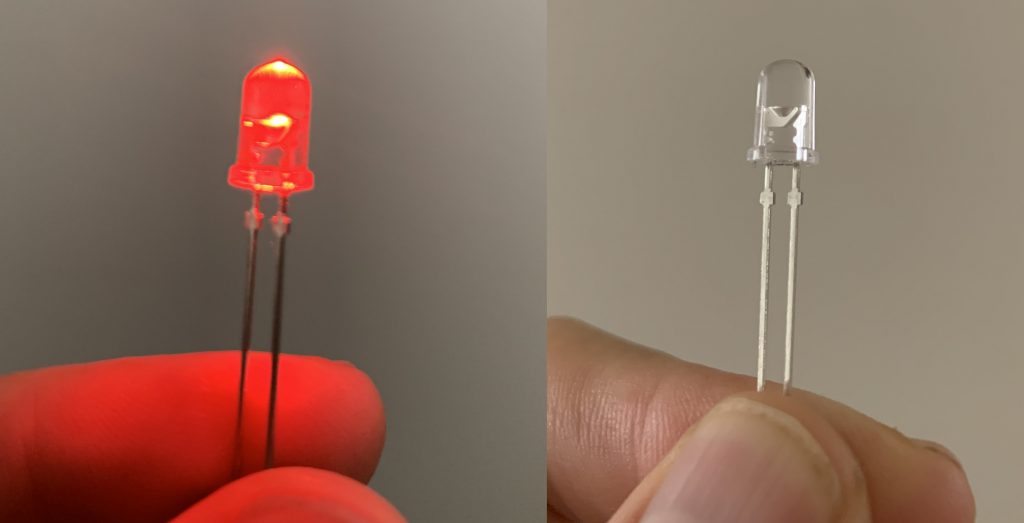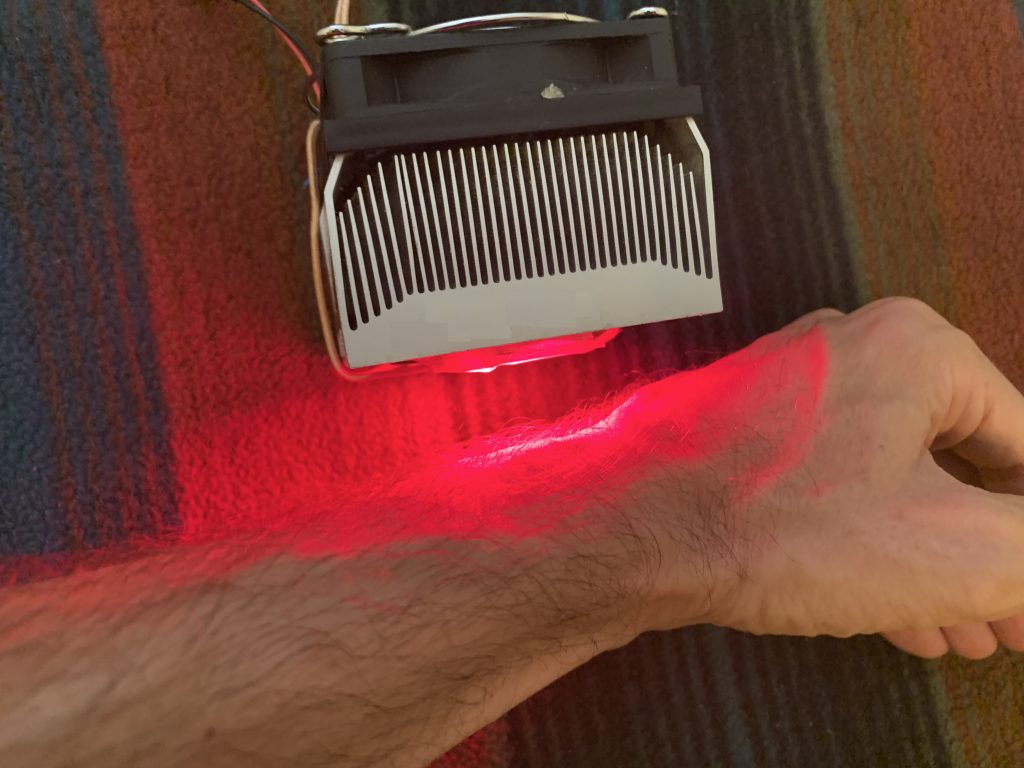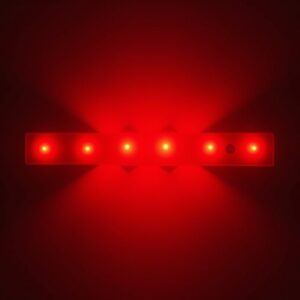Red Light Therapy
It sounds like science fiction, yet there’s enough evidence at this point to conclusively state that red light can have significant healing effects on our biology. Initially, the research into light therapy focused mostly on laser therapy starting in the 1960s. It was believed that lasers provided a unique type of light that was able to stimulate healing responses. By the late 1980s, this view was challenged as evidence began to pile up that it wasn’t laser light specifically, but light in general that was able to generate the effects (Basford 1989).

For treatment sessions, lasers have some distinct disadvantages. Since lasers are focused as a tiny spot, treating a large area is difficult and time consuming. In addition, if higher power is required, significant risks due to eye damage can occur if proper precautions aren’t taken.
Light Emitting Diodes (LEDs) can provide specific wavelengths of light, like lasers. However, unlike lasers, they can treat large areas with decreased risks for eye damage due to their diffuse nature. With LEDs, the light is not focused, but can be spread out easily over a wide area.
How Does Red Light Therapy Work?
Red light therapy appears to stimulate the function of specific enzymes throughout the body. Light has energy. Certain enzymes absorb frequencies of red light, increasing their energy which increases the function of the enzyme. The best studied examples are the cytochrome complexes, enzymes used to produce energy inside the cell. When these cytochrome complexes are irradiated with red light, they increase energy production. Increased energy production can have a whole host of benefits, from improved cellular function to increased cellular repair (Desmet 2006).
Other theories also exist for the benefits of red light therapy. Water inside cells exists primarily as an “interfacial water layer”. In other words, water that is against a surface displays different properties including changes in density and viscosity. Red light appears to decrease the viscosity of this water layer which, when pulsed, may allow for increased cellular uptake of nutrients (Sommer 2019). To take best advantage of this benefit, pulsing frequencies should be slow, between 1 and 10 times per second.
What conditions benefit from red light therapy?
- Parkinson’s disease
- Alzheimer’s dementia
- Traumatic brain injury
- Depression
- Arthritis
- Wound healing
- Psoriasis
Brain Health Benefits of Red Light Therapy
Red light can penetrate through tissues and evidence suggests it can even penetrate through the skull (Pitzschke 2015). Animal studies have shown benefits in a multitude of brain disease models, including eye disease, traumatic brain injury, stroke, ALS, multiple sclerosis, Parkinson’s disease and Alzheimer’s dementia (Johnstone 2016). Red light therapy seems to improve cellular dysfunction caused by toxicants, oxygen deprivation, genetic problems and mitochondrial dysfunction indicating a wide range of benefits.
While research directly on human patients is only beginning, initial trials have shown improvements for a number of conditions. In Parkinson’s disease some patients had improvements for up to 90% of Parkinson’s signs with minimal side effects (Hamilton 2018). A small trial of patients with Alzheimer’s dementia, cognitive function improved and was accompanied by increased blood flow to the brain after red light treatment (Chao 2019). In a separate small study in patients with severe traumatic brain injury, light therapy again increased blood flow and oxygenation to the brain which led to improved function (Carneiro 2019).
For depression, both animal models and human trials indicate significant improvements with few side effects (Askalsky 2019). Results again seem to be tied to increased blood flow and improved brain function.
Arthritis
While research into treating arthritis pain and disability primarily focuses on the use of lasers, most evidence suggests lasers and LEDs have similar effects. Preliminary animal studies suggest LEDs are helpful for arthritis and additional human trials are ongoing (Oshima 2011, Kuboyama 2012, Kuboyama 2014).
A recent review of the evidence for low level laser therapy on knee arthritis confirmed improvements seen with treatment. The review included 22 trials with over a thousand patients. Studies that used an adequate treatment duration showed an average of 32% reduction in pain levels and improved disability 2-4 weeks post treatment (Stausholm 2019). Longer followup showed treatment benefits started to fade, indicating additional treatment sessions might be helpful to maintain pain relief.
Wound Healing
In another review on red light therapy and wound healing, in-vitro and animal models again showed the basic equivalence of laser and LED (Chaves 2014). Red light was shown to decrease inflammation, increase fibroblasts, blood vessels and connective tissue production. The most important factors for achieving benefits were the wavelength of light and the total amount of exposure.
Diabetic patients often develop severe non-healing wounds due to poor blood flow. A clinical trial using LEDs showed faster wound healing compared to placebo for red light therapy (Frangez 2018).
Psoriasis
Psoriasis is an autoimmune skin disease that can result in itchy, painful skin lesions that occur over multiple parts of the body. Standard treatments usually revolve around steroids and immunosuppressants, although ultraviolet light has also been used.
More recently, LED therapy is showing preliminary, promising results. Nine patients with psoriasis that was resistant to standard treatments were treated with two different frequencies of red light for 40 minutes every 2 days for 4-5 weeks. Clearance of the resistant plaques was from 60-100%. Patients experienced no side effects from red light therapy (Ablon 2010).
Treatment Devices

There are numerous devices available for sale, many of which can be expensive, although cheaper devices that should still yield benefits exist. The core LEDs are not expensive to produce, especially red and deep red varieties (630 nm and 660 nm).
The color or wavelength of red light does vary from study to study, with most studies using wavelengths between 630 nm to 1060 nm. These wavelengths span from red to near infrared. Wavelengths above 800 nm are mostly invisible to the human eye, which does complicate safety somewhat, since the device can actually be quite “bright” and yet invisible to the human eye.
Having an interest in light therapy, I’ve built numerous LED therapy devices myself. While not a cure-all, I have noticed benefits. None of my devices are FDA approved, so I’ve never been able to use them on patients.
Conclusions
Red light therapy is a fascinating approach for treating a number of conditions, from helping heal the brain, to supporting skin, joints and connective tissue. When used properly, Red light therapy with LEDs is safe and may provide a number of significant benefits.



